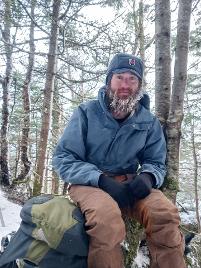Campfire Wood
creative nonfiction by Kyle Mills
There’s a large spruce back from camp a ways, but still close enough to keep a keen eye on all the students. I lean against the old tree and tilt my hat back a little and look up into the canopy. I trace the limbs against the skylight like my grandpa taught me to while hunting. I’m hoping I might catch a glimpse of a West Virginia Northern Flying Squirrel (Glaucomys subrinus fuscus) sunning itself before its nocturnal hunt for fungi. These critters are incredible. They have been in West Virginia as long as the red spruce has—which is their habitat niche. The ancestors of the flying squirrels in this grove watched the wooly mammoths disappear and lumberjacks come. How any of them survived the rampant destruction of their only home, the high red spruce forests, is anyone’s guess. They are resilient little mountaineers that went from the verge of extinction to ever increasing numbers in a direct correlation to the regrowth of red spruce habitat.
The young spruce trees around here give me hope—and I’d be nothing without my hope. Planting red spruce is something that makes me feel the same as leading students into the woods—a little like it’s two means to the same end. I’ve long said that the Dibble Bar is more than just a tool for making holes in the ground—it’s also the best weapon for the inconvenient revolution. I won’t be around to lean against the trees I’ve planted—but someone hopefully will—and with any luck there will be so many flying squirrels by then that they won’t have to look as hard for them as I do.
I gather wood and head back to camp. There’s no better campfire wood than dry spruce. It burns quick, but it is hot and smells the way a campfire should. The coals are perfect for cooking over, but the best use of spruce wood is being the center of conversations happening around it. And something primal comes out of the smoke. The smell of burning spruce reminds me of something I somehow can’t recall. I’ve sat and watched spruce smoke wander through the forest.
As we sit in a circle, we talk about the day, reflect on what we learned, what we did, and most importantly, what we could do better. The burning spruce slows everything down. It gives us time for reflection. It is a tool for critical thinking. The way the flames burn provides heat, but the way the flames dance gives holy energy. The smoke wafts past, rising with my thoughts towards the stars—bringing things to mind I would not have thought of under ordinary places.
“See those seven stars up there?” I point out Ursa Major, the Big Bear, in the sky visible between the tops of the spruce brushing against the universe, “I’m goin’ to tell you the oldest story that I know.”
The spruce crackles in the fire and glows on the faces around the campfire maybe—just maybe—like it did the first time the story was told.

Kyle Mills is a West Virginian and lives at the Spruce Knob Mountain Center, works as a climbing instructor for Seneca Rocks Mountain Guides, and is also an adjunct professor of backpacking at Davis and Elkins College. Kyle is the author of Field Notes from the Alleghenies.
